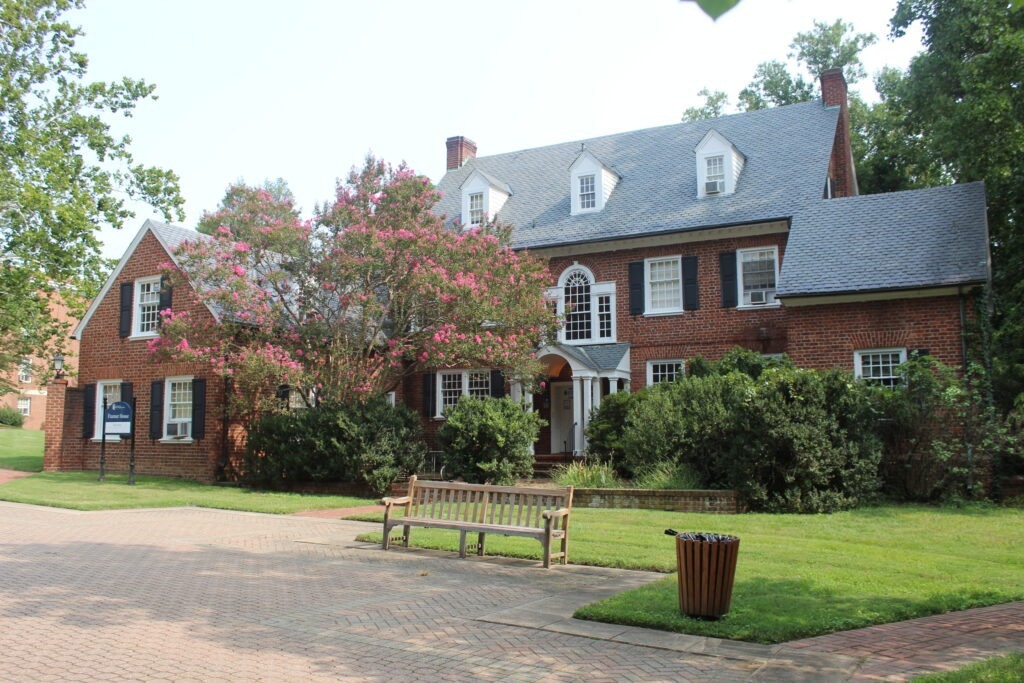UMW’s Intercultural Living Learning Community may be forced to move from Framar Hall
4 min read
The University of Mary Washington’s Framar House, home to the International Living Community, is located behind Jefferson Hall and beside South Hall. | Kaitlin Laskowski, The Blue & Gray Press
MICHEAL SILBERSTEIN
Staff Writer
Editor’s note: Kate Seltzer, editor-in-chief of The Blue & Gray, currently serves as co-president of Framar House. She is not represented in this story, but she did make final edits for grammar and clarity.
The Intercultural Living Learning Community (ILLC), which is currently housed in Framar House, might be forced to move into another housing facility on campus due to the inaccessibility of the historic building.
Due to Framar House’s long history, many of the building’s features are out of date and are not easily accessible to those with mobility impairments. This includes the building’s narrow staircases, lack of elevator and lack of an accessible ramp.
Framar House, which previously served as the “Spanish House” as a result of housing advanced students majoring in Spanish, now holds up to 19 students (not including an RA) who must apply separately to live in the ILLC . According to UMW’s residence life website, “students must complete an application each spring to become or continue to be a member of the ILLC during the next academic year.”
This application is separate from the main housing application that most students complete to live on campus during the school year.
Many Framar residents said the exclusivity of the ILLC and the smaller community that it offers is a big appeal. This tight knit community, in combination with Framar House’s communal and older layout, is a plus for a lot of potential Framar residents.
During the 2020-2021 school year, a group of Framar residents attempted to improve the building’s accessibility through the creation of a ramp. They pushed for a general call to action on behalf of the University to update the building’s accessibility features.
In the spring of 2021, students were told by Residence Life that the ILLC would need to be relocated from Framar House.
“[We were told that] because Framar is an exclusive program, by having us live in an inaccessible building, we were breaking the law…therefore we would not be able to live in Framar anymore,” said Eden Shenal, a sophomore political science major and Framar resident.
The University argued that the ability for students to choose the members that join the ILLC in combination with Framar’s physical inaccessibility creates the potential for discrimination. While no student has ever made a complaint or petition to the University’s Office of Disability Resources (ODR) based on this topic, the issue of inaccessibility still must be sorted out by Framar residents and the University if the ILLC is to remain in Framar House.
“The requirement for us as an institution of public education is really based around the ability to access an opportunity of a program we are sponsoring,” said Jessica Machado, director of the ODR. Since students with mobility disabilities potentially do not have the ability to access the ILLC due to its location, Framar House needs renovations or the ILLC needs a new location.
“The discussions to move the Intercultural Living Community to an accessible building is part of a larger project to move all living learning/themed communities to accessible spaces on campus,” said David Fleming, assistant dean of Residence Life and Housing. “Framar House would need considerable renovations to meet [the Americans with Disabilities Act] standards for accessibility.”
Senior Beck Zytowski, an English major and current co-president of Framar House, said they and other Framar residents “wanted to change Framar house, and that the University told us it was possible, but we would just have to do that ourselves,” in reference to raising funds.
While the University could use its own resources to renovate the Framar House, UMW has limited resources, especially due to budget cuts from COVID-19. With multiple issues of inaccessibility and the lack of available funds in this school’s current budget, Fleming states that the University might decide to relocate the program to an area that is already accessible for all.
Many Framar residents attest to how the house helps foster the ILC community, but from interviews many of the best memories students have are from the relationships they formed while in Framar.
“The best thing was getting to know different people from around campus and international students,” said Maddie Ownby, a former Framar resident and senior anthropology major.
Students attempted to mobilize in the spring semester and rallied around the hashtag “save Framar,” although they were greatly hindered by the spread of COVID-19 and the following social shutdown.
“Considering everything that has happened, I feel like it’s not going to work out that well for us,” said Zytowski.
For now, Framar House is still the home of the ILLC and students that had applied are currently living in the house. Framar residents and volunteers have until the end of the 2020-2021 academic year to take initiative and improve the building before the ILLC location will be reevaluated.
The continued social limitations, as a result of COVID-19, mean that mobilization, fundraising, and outreach have been squandered. It is unlikely that Framar House will be renovated without the funds and help of the University.
As Framar House’s fate is brought into question, students wonder if its past as the center of UMW’s international community or its architectural history will define its future.











